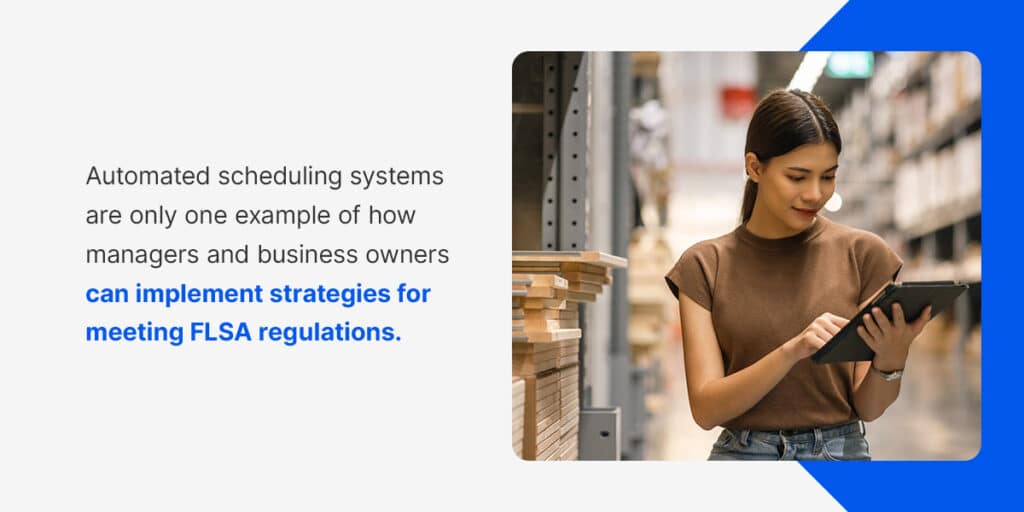In 2021, the Wage and Hour Division found four healthcare agencies were responsible for violating the Fair Labor Standards Act by neglecting to pay employees correctly. Between failure to pay required overtime and employee misclassification, these home health industry employers owed over $1.2 million in back wages. As a facility manager, owner, or director, meeting FLSA regulations is imperative to avoid hefty fines and penalties.
Innovative workforce management solutions can help your organization maintain FLSA compliance by streamlining everyday tasks like scheduling, attendance, and payroll. We’re here to help you understand the historical significance and the evolution of the Fair Labor Standards Act.
What Is the Fair Labor Standards Act?
Congress enacted the Fair Labor Standards Act in 1938. This law created sweeping changes by protecting workers against unfair employment practices. Over the years, many FLSA updates and revisions have reformed the American workforce. This impact of labor laws on workers and employers was far-reaching, contributing to safer, healthier work environments.
Here’s an overview of the Fair Labor Standards Act details, provisions, and coverages.
- Overtime: Have you ever wondered where the term “time-and-a-half” originated? The FLSA created it. Employers must provide overtime pay of no less than one and a half times their regular pay rate for employees who work more than 40 hours weekly.
- Standard workweek: In 1940, FLSA revisions defined a maximum workweek of 40 hours. Employees who work more than this are eligible for time-and-a-half pay. This regulation also prevents employers from averaging workweeks to avoid paying overtime. For instance, if an employee works 33 hours one week and 46 the next, employers cannot average the hours to say there is no need to pay overtime.
- Minimum wage: As of 2009, workers covered under the FLSA must earn a minimum of $7.25 per hour.
- Child labor: The FLSA prohibits children under 16 from working in hazardous occupations. Children also receive a minimum hourly wage and can only work a limited number of hours, especially during the school day.
- Exemptions: Though the FLSA applies to many employees and employers, it is not universal. Independent contractors, outside salespeople, seasonal employees, and volunteers are some examples of those who may not fall under FLSA jurisdiction.
The Role of Automated Scheduling in Maintaining Fair Labor Standards

The impact of labor laws on employers like you has led to the development of robust workforce management systems. Automated scheduling systems are only one example of how managers and business owners can implement strategies for meeting FLSA regulations.
Some advantages of automated scheduling systems include:
- Automates time-consuming, repetitive tasks of creating and adjusting schedules
- Frees up employer time for more strategic initiatives
- Minimizes shift planning errors
- Provides real-time visibility into employee schedules and work hours
- Promotes transparency and accountability
- Enables quick decision-making during unexpected changes or challenges
- Helps ensure equitable shift distribution and compliance with labor standards
- Improves ability to identify and rectify inefficiencies
- Prevents over- or understaffing and unnecessary overtime
- Contributes to a positive work environment that upholds fairness and autonomy
- Enables overtime control depending on schedule needs
- Easily view past schedules to forecast future labor demands
- Minimizes scheduling conflicts to ensure adequate coverage
- Automatically records worked hours, overtime, and breaks for an error-free payroll process
- Allocates resources for demand fluctuations
- Maintains accurate records for compliance with labor laws
There is an inextricable connection between FLSA compliance and workforce management. With the benefits of automated scheduling and workforce analytics, you can allocate more time and resources to maintaining compliance. As a result, you’ll also get to focus on other high-priority tasks like safeguarding your workers’ well-being and creating a positive work environment.
Adapting Workforce Management Strategies to FLSA Regulations
Like most laws, the FLSA is subject to change over time. For employers and business owners, this means staying informed about changes and adapting compliance strategies to meet evolving requirements. Implementing strategies for effective workforce planning can help you mitigate legal risks and penalties for noncompliance.
Here are some ways to adapt your workforce management processes to meet FLSA responsibilities.
- Monitor overtime: Carefully track overtime hours within your organization and accurately compensate employees to ensure compliance. Relying on manual methods for this can lead to human error, but intelligent software can simplify these complex processes.
- Provide ongoing training: Communication is imperative in any workplace. Training your employees and managers can promote a culture of ethical business practices and compliance. Your employees deserve to know their rights and comprehensively understand your overtime policy and exemptions.
- Conduct regular audits: Understandable, accurate records provide evidence of your adherence to FLSA regulations. Maintain legal compliance with wage and hour laws for your workforce by conducting regular FLSA audits. Audits can also lead to cost savings opportunities and enable you to review and update your internal processes as needed.
- Implement modern solutions: Workforce management solutions simplify compliance with workplace laws and regulations with strategic workforce analytics. Reduce your compliance risk and enhance consistency with cutting-edge tools that help you advance your scheduling and management processes.
The Future of Fair Labor Standards — Predicting Changes and Preparing Proactively
There are some proposed FLSA updates for 2023 and 2024. The most notable is the White-Collar Exemption. This U.S. Department of Labor proposal seeks to increase the salary threshold for executive, administrative, and professional employees from $684 to $1,059 weekly. The DOL aims to release its final ruling on this potential 55% increase in minimum salary requirements in April 2024.
Other final rulings for proposals may take effect in 2024, including the Independent Contractor Rule and Joint Employer Rule. The first would outline what determines whether a worker is an employee or an independent contractor. The second, which is effective starting Feb. 26, 2024, details that two or more entities may have joint employer status if they co-determine the terms and conditions of employment.
These latest updates imply that business owners and managers must closely monitor employment and labor law changes to stay ahead of compliance. Your business can prepare for 2024 workforce changes and remain agile by taking proactive measures and implementing adaptive solutions.

Streamline Your Workforce Management Priorities With Indeavor
The FLSA protects workers from unfair working conditions and wages. Whether you’re in the manufacturing, food processing, or oil and gas industry, failing to meet these regulations can result in civil money penalties. With a high-quality, scalable workforce management system, you can view your organization holistically to close compliance gaps. You can also optimize your staffing levels, increase efficiency, and lower labor costs.
By transforming your scheduling processes, you can prioritize FLSA compliance and effectively manage your workforce. If you want to learn how to future-proof your business, book a live demo today to see how our technology can revolutionize your workforce and operations.







